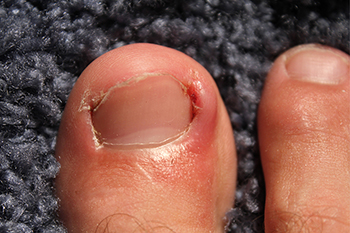 Ingrown toenails occur when the edges of a toenail grow into the surrounding skin. This commonly causes pain, redness, and swelling. Effective management techniques include proper toenail trimming, such as cutting nails straight across without rounding the corners and wearing shoes that provide ample space for the toes. This is because excessive pressure on the nails is partly what leads to ingrown toenails. For recurring or severe cases, a podiatrist, or foot doctor, can offer professional treatments. One treatment includes lifting the nail edge and placing a small splint to allow the nail to grow above the skin level. In some instances, a minor surgical procedure might be necessary. In this case, a podiatrist removes part of the offending nail and may treat the nail bed to prevent the problematic portion of the nail from growing back. Podiatrists can also provide guidance on foot hygiene and footwear to prevent future ingrown toenails. Addressing ingrown toenails professionally helps both reduce pain and prevent infections. If you are suffering from an ingrown toenail, it is suggested that you consult with a podiatrist for care.
Ingrown toenails occur when the edges of a toenail grow into the surrounding skin. This commonly causes pain, redness, and swelling. Effective management techniques include proper toenail trimming, such as cutting nails straight across without rounding the corners and wearing shoes that provide ample space for the toes. This is because excessive pressure on the nails is partly what leads to ingrown toenails. For recurring or severe cases, a podiatrist, or foot doctor, can offer professional treatments. One treatment includes lifting the nail edge and placing a small splint to allow the nail to grow above the skin level. In some instances, a minor surgical procedure might be necessary. In this case, a podiatrist removes part of the offending nail and may treat the nail bed to prevent the problematic portion of the nail from growing back. Podiatrists can also provide guidance on foot hygiene and footwear to prevent future ingrown toenails. Addressing ingrown toenails professionally helps both reduce pain and prevent infections. If you are suffering from an ingrown toenail, it is suggested that you consult with a podiatrist for care.
Ingrown toenails can become painful if they are not treated properly. For more information about ingrown toenails, contact Dr. Lubrina Bryant of District Podiatry, PLLC. Our doctor can provide the care you need to keep you pain-free and on your feet.
Ingrown Toenails
Ingrown toenails occur when a toenail grows sideways into the bed of the nail, causing pain, swelling, and possibly infection.
Causes
Prevention
Because ingrown toenails are not something found outside of shoe-wearing cultures, going barefoot as often as possible will decrease the likeliness of developing ingrown toenails. Wearing proper fitting shoes and using proper cutting techniques will also help decrease your risk of developing ingrown toenails.
Treatment
Ingrown toenails are a very treatable foot condition. In minor cases, soaking the affected area in salt or antibacterial soaps will not only help with the ingrown nail itself, but also help prevent any infections from occurring. In more severe cases, surgery is an option. In either case, speaking to your podiatrist about this condition will help you get a better understanding of specific treatment options that are right for you.
If you have any questions please feel free to contact our office located in Washington, D.C . We offer the newest diagnostic and treatment technologies for all your foot and ankle needs.